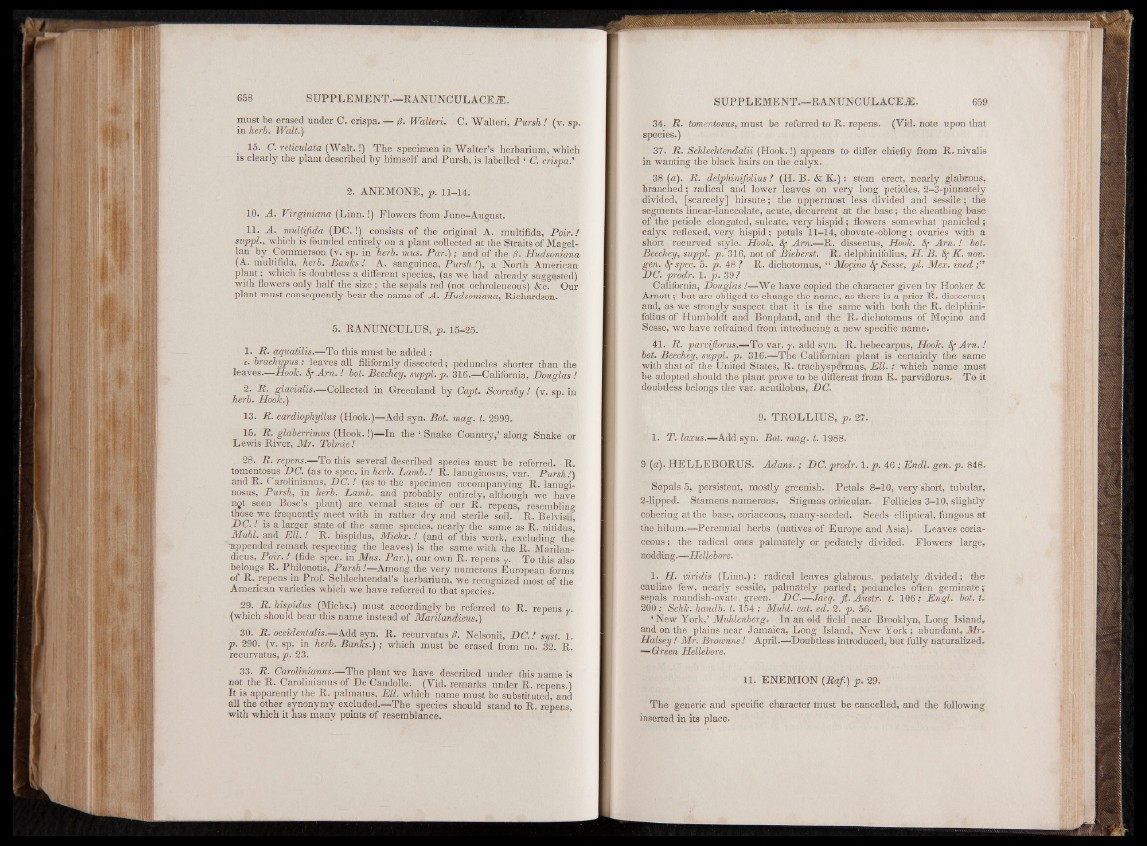
must be erased under C. crispa. — 0. Walteri. C. Walteri, Pursh ! (v. sp.
in herb. Walt.)
15. C. reticulata (Walt. !) The specimen in Walter’s herbarium, "which
is clearly the plant described by himself and Pursh, is labelled ‘ C. crispa.'
2. ANEMONE, p. 11-14.
10. A. Virginiana (Linn.!) Flowers from June-August.
11. A. multijida (DC.!) consists of the original A. multifida, Pair.!
suppl., which is founded entirely on a plant collected at the Straits of Magellan
by Commerson (v. sp. in herb. mus. Par.); and of the /?. Hudsonxana
(A. multifid?t, herhl Banks! A. sanguinea, Pursh /), a North American
plant; which is doubtless a different species, (as we had already suggested)
with flowers only half the size ; the sepals red (not ochroleucous) &c. Our
plant must consequently bear the name of A. ffudsoniana, Richardson.
5. RANUNCULUS, p. 15-25.
1. R. aquatilis.—To this must be added :
c. brachypus: leaves all filiformly dissected; peduncles shorter than the
leaves. Hook, t)* Am. ! bot. Beechey, suppl. p. 316.—California, Douglas !
2. R. glacialis.—Collected in Greenland by Capt. Scoresby! (v. sp. in
herb. Hook.)
13. It. cardiophyllus (Hook.)—Add syn. Bot. mag. t. 2999.
15. R. glaberrimus (Hook.!)—In the ‘ Snake Country,’ along Snake or
Lewis River, Mr. Tolmie !
28. R. repens.—To this several described species must be referred. R.
tomentosus DC. (as to spec, in herb. Lamb.! R. lanuginosus, var. Pursh!)
and R. Carolinianus, DC. ! (as to the specimen accompanying R. lanuginosus,
Pursh, in herb. Lamb. and probably entirely, although we have
ngt seen Bose’s plant) are vernal states of our R. repens, resembling
those we frequently meet with in rather dry and sterile soil. R. Belvisii,
DC. ! is a larger state of the same species, nearly the same as R. nitidus]
Muhl. and Ell. ! R. hispidus, Michx. ! (and of this work, excluding the’
“appended remark respecting the leaves) is the same with the R. Marilan-
dicus, Pair.! (fide spec, in Mus. Par.), our own R. repens y. To this also
belongs R. Philonotis, Pursh!—Among the very numerous European forms
of R. repens in Prof. Schlechtendal’s herbarium, we recognized most of the
American varieties which we have referred to that species.
29. R. hispidus (Michx.) must accordingly be referred to R. repens y.
(which should bear this name instead of Marilandicus.) 1
30. R. occidentalis.—Add syn. R. recurvatus 0. Nelsonii, DC.! syst. 1.
p. 290. (v. sp. in herb. Banks.); which must be erased from ho. 32. R.
recurvatus, p. 23. 3
33. R. Carolinianus. The plant we have described under this name is
not the R. Carolinianus of De Candolle. (Vid. remarks under R. repens.)
It is apparently the R. palmatus, Ell. which name must be substituted, and
all the other synonymy excluded.—The species should stand to R. repens,
with which it has many points of resemblance.
34. R. tomentosus, must be referred to R. repens. (Vid. note upon that
species.)
37. R. Schlechtendalii (Hook.!) appears to differ chiefly from R.nivalis
in wanting the black hairs on the calyx.
38 (fit). R. delphinifolius ? (H. B. & IL ): stem erect, nearly glabrous,
branched; radical and lower leaves on very long petioles, 2-3-pinnately
divided, [scarcely] hirsute; the uppermost less divided and sessile; the
segments linear-lanceolate, acute,'decurrent at the base; the sheathing base
of the petiole elongated, sulcate, very hispid; flowers somewhat panicled ;
calyx reflexed, very hispid; petals 11-14, obovate-oblong; ovaries with a
short recurved style. Hook, fc Am.—R. dissectus, Hook. Am. ! bot.
Beechey, suppl. p. 316, not of Bieberst. R. delphinifolius, H. B. K. nov.
gen. 8f spec. 5. p. 48 ? R. dichotomus, “ Mocino Sf Sesse, pi. Mex. ined
DC. prodr. 1. p. 39?
California, Douglas !—We have copied the character given by Hooker &
Arnott; but are obliged to change the name, as there is a prior R. dissectus;
and, as we strongly suspect that it is the same with both the R. delphinifolius
of Humboldt and Bonpland, and the R. dichotomus of Mocino and
Sesse, we have refrained from introducing a new specific name.
41. R. parvijlorus.—To var. y. add syn. R. hebecarpus, Hook. Sf Am . !
bot. Beechey, suppl. p. 316.—The Californian plant is certainly the same
with that of the United States, R. trachyspffrmus, Ell. ; which name must
be adopted should the plant prove to be different from R. parviflorus. To it
doubtless belongs the var. acutilobus, D C .
9. TROLLIUS, p. 27.
1. T. laxus.—Add syn. Bot. mag. t. 1988.
9 (a). HELLEBORUS. Adans. ; DC. prodr. 1. p. 46 ; Endl. gen. p. 848-
Sepals 5, persistent, mostly greenish. Petals 8-10, very short, tubular,
2-lipped. Stamens numerous. Stigmas orbicular. Follicles 3-10, slightly
cohering at the base, coriaceous, many-seeded. Seeds elliptical, fungous at
the hilum.—Perennial herbs (natives of Europe and Asia). Leaves coriaceous
; the radical ones palmately or pedately divided. Flowers large,
nodding.—Hellebore. ~
1. H. viridis (Linn.): radical leaves glabrous, pedately divided; the
cauline few, nearly sessile, palmately parted; peduncles often geminate;
sepals roundish-ovate, green. DC.—Jacq. fl. Austr. t. 106; Engl. bot. t.
200; Schk. handb. t. 154; Muhl. cat. ed. 2. p. 56.
‘New York,’ Muhlenberg. In an old field near Brooklyn, Long Island,
and on the plains near Jamaica, Long Island, New York; abundant, Mr.
Halsey! Mr. Broumne ! April.—Doubtless introduced, but fully naturalized.
—Green Hellebore.
11. ENEMION (Raf.) p. 29.
The generic and specific character must be cancelled, and the following
inserted in its place.